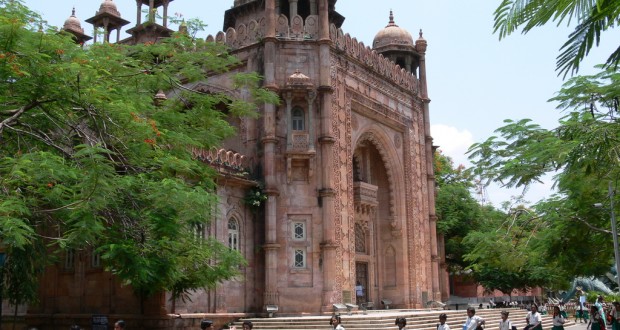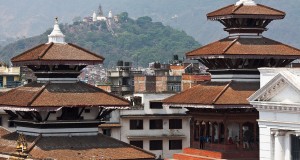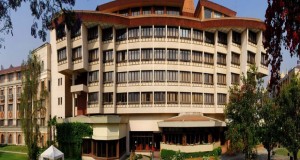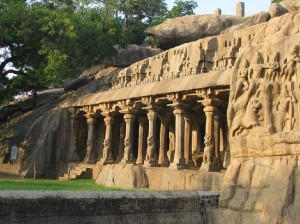 Delhi and Calcutta in three major respects. First, it is the home of the ancient Dravidian civilisation, hardly touched by the invasions from the north, and often claimed to be ‘pure’ Indian. Next, it is still unusually spacious: a wide, green and airy 80 sq km (31 sq miles) of parks and gardens, beaches and esplanades with very few built-up areas despite a population of 5.5 million. (Although, in the last few years land prices have soared and a number of new high-rise buildings have started to spring up.) Last, it has managed to grow from rural village to modern metropolis in 350 years without losing much of its simple charm.All three factors have combined to give Madras and the south in general growing popularity as a tourist destination. An important port, Madras has a long history of association with other cultures.The names of many of its streets—Armenian Street, China Bazaar Road, Portuguese Church St and so on—reflect its early days of international trade importance. Even before the British arrived, its precious cargoes of handlooms, fabrics, silk and hides had attracted European interest, leading to the establishment of a small Portuguese settlement at San Thome. Madras was also the first English settlement in India. The East India Company arrived here in 1639, and was granted by the Rajah of Chandragiri the small village of Chennapatnam (later the city of Madras), located between the ancient towns of Mylapore and Triplicane in the south and Tiruvottiyur in the north. On this site, in 1641, the Company constructed Fort St George and began exporting cloth home. To the north of the European fort arose a second town, called Madraspatnam or ‘Black Town’ for the Indian community, which later (following King George’s visit in 1911) became the present Georgetown.Following its grant of a municipal charter in 1688 by James II making it the oldest • Municipal
Delhi and Calcutta in three major respects. First, it is the home of the ancient Dravidian civilisation, hardly touched by the invasions from the north, and often claimed to be ‘pure’ Indian. Next, it is still unusually spacious: a wide, green and airy 80 sq km (31 sq miles) of parks and gardens, beaches and esplanades with very few built-up areas despite a population of 5.5 million. (Although, in the last few years land prices have soared and a number of new high-rise buildings have started to spring up.) Last, it has managed to grow from rural village to modern metropolis in 350 years without losing much of its simple charm.All three factors have combined to give Madras and the south in general growing popularity as a tourist destination. An important port, Madras has a long history of association with other cultures.The names of many of its streets—Armenian Street, China Bazaar Road, Portuguese Church St and so on—reflect its early days of international trade importance. Even before the British arrived, its precious cargoes of handlooms, fabrics, silk and hides had attracted European interest, leading to the establishment of a small Portuguese settlement at San Thome. Madras was also the first English settlement in India. The East India Company arrived here in 1639, and was granted by the Rajah of Chandragiri the small village of Chennapatnam (later the city of Madras), located between the ancient towns of Mylapore and Triplicane in the south and Tiruvottiyur in the north. On this site, in 1641, the Company constructed Fort St George and began exporting cloth home. To the north of the European fort arose a second town, called Madraspatnam or ‘Black Town’ for the Indian community, which later (following King George’s visit in 1911) became the present Georgetown.Following its grant of a municipal charter in 1688 by James II making it the oldest • Municipal 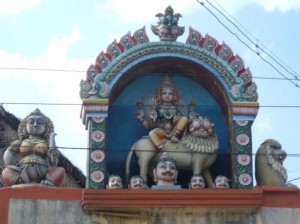 Corporation in India, Madras became a battleground for competing French and British trading interests throughout the 18th century, and was even occupied by the French for a brief spell (1746-9) before the young Clive removed them at the 1751 Battle of Arcot. Though replaced a short time later by Calcutta as the primary British settlement (1772), it continued through the 19th century to be one of the four major seats of British Imperial power in India. Under the 1 Madras Presidency, the city expanded rapidly outwards, giving birth to a relaxed, open garden city of clubs, churches, parks and elegant Victorian monuments. Today, Madras is moderating its traditional textile-based economy in favour of rapid industrial and technological development, but it still remains a pleasant, semi-rural town, a unique blend of the old and the new.Many feel Madras to be the most pleasant introduction to India: it lacks the crowds, noise and pressure of Bombay and Calcutta, and it is possible to orient 1 to the Asian way of life much more quickly. There is no cushioning effect here: you’re face-to-face with ‘real India’ right from the start. Madras is a typical Indian city: one minute you’ll be walking along an elegant main thoroughfare admiring well-to-do Madrassi women, sweet-smelling jasmine wound into their jet-black hair; the next, you’ll turn into a dirty, crowded street full of thin men on the pavements in dusty sarongs, and even thinner mothers with ragged babies. But if the sights are contrasting, the people are uniform: dark-skinned, shock-haired; irrepressibly friendly and insatiably curious Tamils with an obsessive love of foreigners. Here, a casual enquiry for directions will get you a vast, swaying crowd of helpful locals within seconds. They’ll even follow you down the road afterwards, just in case you want something else.WHEN TO GO
Corporation in India, Madras became a battleground for competing French and British trading interests throughout the 18th century, and was even occupied by the French for a brief spell (1746-9) before the young Clive removed them at the 1751 Battle of Arcot. Though replaced a short time later by Calcutta as the primary British settlement (1772), it continued through the 19th century to be one of the four major seats of British Imperial power in India. Under the 1 Madras Presidency, the city expanded rapidly outwards, giving birth to a relaxed, open garden city of clubs, churches, parks and elegant Victorian monuments. Today, Madras is moderating its traditional textile-based economy in favour of rapid industrial and technological development, but it still remains a pleasant, semi-rural town, a unique blend of the old and the new.Many feel Madras to be the most pleasant introduction to India: it lacks the crowds, noise and pressure of Bombay and Calcutta, and it is possible to orient 1 to the Asian way of life much more quickly. There is no cushioning effect here: you’re face-to-face with ‘real India’ right from the start. Madras is a typical Indian city: one minute you’ll be walking along an elegant main thoroughfare admiring well-to-do Madrassi women, sweet-smelling jasmine wound into their jet-black hair; the next, you’ll turn into a dirty, crowded street full of thin men on the pavements in dusty sarongs, and even thinner mothers with ragged babies. But if the sights are contrasting, the people are uniform: dark-skinned, shock-haired; irrepressibly friendly and insatiably curious Tamils with an obsessive love of foreigners. Here, a casual enquiry for directions will get you a vast, swaying crowd of helpful locals within seconds. They’ll even follow you down the road afterwards, just in case you want something else.WHEN TO GOThe one big drawback to selecting Madras as an arrival point in India is the heat. The
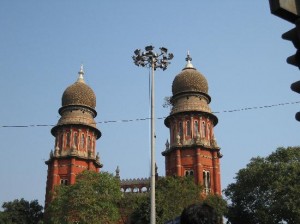 climate is tropical and despite two monsoons a year (June–Aug and Sept–Nov) it is always very hot and very humid. Remember, they’ve named a curry after Madras. Some like the hot humid atmosphere and slip easily into the calm, relaxed pace of life for which Tamil Nadu is famous; others simply melt, and regret not choosing a northern capital in which to adjust to Asian temperatures. The coolest season, but still rather warm, is Dec–Feb, and it’s worth turning up for the Pongal (Spring Harvest) festival of mid-Jan. During this extravaganza, Madras paints itself and its sacred cows in bright colours, and goes singing, dancing and begging for a whole week. Though more sedate, the big Dance and Arts Festival of mid-December is also a major attraction. Madras has any number of festivals, and each one is a near-riot.ARRIVAL/DEPARTURE
climate is tropical and despite two monsoons a year (June–Aug and Sept–Nov) it is always very hot and very humid. Remember, they’ve named a curry after Madras. Some like the hot humid atmosphere and slip easily into the calm, relaxed pace of life for which Tamil Nadu is famous; others simply melt, and regret not choosing a northern capital in which to adjust to Asian temperatures. The coolest season, but still rather warm, is Dec–Feb, and it’s worth turning up for the Pongal (Spring Harvest) festival of mid-Jan. During this extravaganza, Madras paints itself and its sacred cows in bright colours, and goes singing, dancing and begging for a whole week. Though more sedate, the big Dance and Arts Festival of mid-December is also a major attraction. Madras has any number of festivals, and each one is a near-riot.ARRIVAL/DEPARTUREMadras is the Gateway to the south. The perfect base from which to commence one’s discovery of southern India. Air, rail and bus connections are all superb.
Air
Meenambakkam airport is connected by Indian Airlines to Ahmedabad, Bangalore, Bombay, Calcutta, Cochin, Delhi, Hyderabad, Madurai, Port Blair, Trivandrum,
Vizakhapatnam; by Vayudoot with Coimbatore, Madurai and Cochin; and by East West Airlines to Bombay.
International flights are operated by Air India from Frankfurt, Jeddah and Kuala Lumpur; Air Lanka from Colombo; British Airways from London (Heathrow) via Abu Dhabi; Indian Airlines to Colombo and Singapore; Malaysian Airlines from Kuala Lumpur and Singapore Airlines from Singapore.
The airport has international and domestic terminals (linked by Rs5 PTC bus service), and is located 14 km (8 3/4 miles) from the city. From the airport, you’ve a choice of Aviation Express private coach (Rs30), PTC mini-coach (Rs30), taxi (Rsl00- 120) or auto-rickshaw (Rs50-60) into town. It’s a 40-60 minute journey.
Rail
Madras has two stations: Egmore, which serves the south (right down to Kanyakumari), and Central, which connects with the rest of India (notably Bangalore, Bombay and Cochin). Both stations are close to each other, off Poonamallee High Rd, and you can use the suburban trains to get around Madras itself—say, up to Fort St George or to Madras Beach, or down to Guindy for the National Park. Rail reservations are easy; to tap the tourist quota, go to the Indrail office, 2nd floor, inside Central station. It’s open 10 am-6 pm and you don’t need an Indrail Pass for reservations, just your passport.
Road
TTDC buses (for short-range destinations like Mahabalipuram, Kanchipuram, Tirupati etc.) leave from Mofussil bus-stand, off Esplanade Rd. TTC buses go from the nearby Express bus-stand at Parry’s Corner, just behind the High Court building, and service long-haul venues like Hyderabad (15 hrs), Bangalore, Kanchipuram (3 hrs), Coimbatore, Madurai, Mysore (9 hrs), and Trivandrum (16 hrs). Inside the chaotic terminals, there are always kids eager to direct you to the right bus for a small tip. To avoid long queues for tickets, buy them at the TNTDC tourist office, and at the crowded bus-stations. Tamil Nadu has one of the country’s most efficient public transport systems and even the smallest district town is connected with Madras.
GETTING AROUND
Madras divides into three main sections: busy, commercial Georgetown to the north (with GPO, American Express, bazaars, budget hotels, in and around Netaji Subhash Bose Road); Egmore in the city centre (for bus/rail terminals, airline offices, consulates, tourist offices and decent hotels/restaurants, in and around Anna Salai/ Mount Rd); and Guindy/Adyar, the quiet, rural ‘green belt’ (with wildlife park, beaches and Theosophical Society) to the far south.
Getting around Madras, you have two problems: first, all the streets were renamed following Independence, and the new names haven’t stuck (everybody still calls Anna Salai, Madras’s chief thoroughfare, by its old title of Mount Road); second, transport round town is hit-and-miss. The inner city is crowded with unemployed auto- and cycle-rickshaws who’ll do anything, even mount the pavement, to get your business. But few of them speak English, and even fewer know where they are going. With rickshaws always fix the cost of the journey—around Rs2.50 per km for auto-rickshaws, Rsl.50 per km for cycle-rickshaws—in advance. Sometimes it’s better to hire a taxi as they do tend to use meters, and have a better sense of direction. Most travellers see Madras by bicycle.

